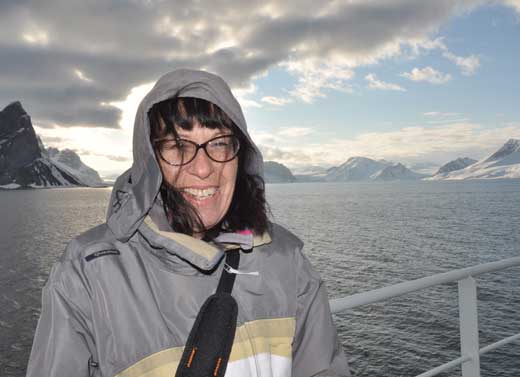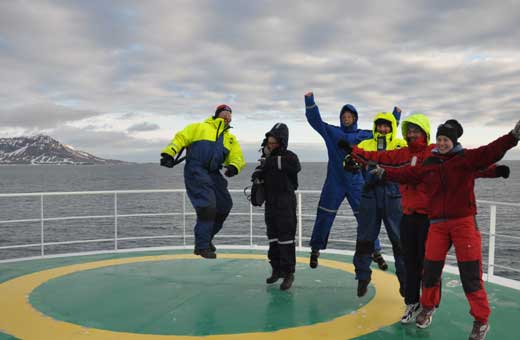Teacher on the high seas Inspire article
Educator, student and Arctic explorer combined – Giulia Realdon can’t think of a better job than being a science teacher.
Last summer, Giulia Realdon got on a plane and travelled from her home in northern Italy to Tromsø in Norway. There, she joined scientists from around the world on an oceanographic cruise in the Arctic. For 11 days she took part in experiments, interviewed researchers and shared the highs and lows of the crew as the ship travelled as far north as Svalbard before returning to Tromsø with data and samples. “It was a once in a lifetime adventure,” enthuses Giulia, who describes the scientists on board as “amazing people”.

Image courtesy of Giulia Realdon
Giulia’s opportunity was part of the ‘Teacher at sea’ programme, organised by the European Geosciences Union (EGU), the French Polar Institute (IPEV) and Eurofleets 2 EU project. It was a lucky second chance for Giulia, who had first been scheduled to take part in the programme in 2012, with a cruise to the South China Sea.
Delays, caused in part by geopolitics, forced the 2012 expedition to be rescheduled to take place during exam season. Giulia had to cancel. “So when they phoned me up to offer me this second chance I couldn’t believe it,” she explains excitedly, “I had to go!” That new expedition was the PREPARED cruisew1, a multidisciplinary voyage co-ordinated by the Italian Osservatorio Nazionale di Oceanografia e di Geofisica Sperimentale (the national observatory of oceanography and experimental geophysics, OGS) to investigate and define the past and present oceanographic conditions around areas of the seabed located on the eastern side of the Fram Strait between Greenland and Svalbard, Norway.
On board, as the ship sailed in the Arctic seas, work was carried out 24 hours a day to take advantage of the continual sunlight, but each research group worked only for two four-hour shifts per day. Giulia logged data for Eli Anne Esrdal, an oceanographer from University Centre in Svalbard, who was taking water samples to measure the salinity, temperature, density and oxygen content, but she also got to meet many of the researchers and learn about what they were studying. Giulia wrote up many of these interviews on her blog, which she kept updated (in English and Italian) during her voyagew2.

When asked about memorable sights, Giulia can describe the amazing views from the boat or watching minke whales swim alongside, but her most enthusiastic answer involves the science itself – watching cores of the sea floor being safely brought aboard. “It was something that’s technically amazing but also with a lot of suspense – will it succeed? That needs a lot of knowledge but also a lot of luck,” says Giulia, who remembers the spontaneous applause and dancing that broke out on board when the cores were safely delivered. “The history of 20 000 years from the last glaciation to the present was in those sediment cores,” she explains.
One of the newest research areas that Giulia first encountered on the cruise was the issue of microplastics, small pieces of plastic and fibres under 5 mm in size. This topic is an unfamiliar one for students but interest is rising, explains Giulia. “The problem,” she adds, “is that the microplastics accumulate in different sea layers and enter the food chain.” The full extent of the problem is still being explored, including where most of these plastics finally go.
With a degree in biology and a master’s in science communication as well as her teaching qualification, Giulia taught natural sciences at secondary-school level for her whole career before officially retiring. But rather than putting her feet up, Giulia is now studying for a PhD in earth science education at the University of Camerino and is also the chair of the Scienza Under 18 Isontinaw3, her local chapter of Scienza Under 18 (Science under 18), a science communication association in Italy aimed at communicating science to young people.
Many of Giulia’s career opportunities have come, she says, from attending European events such as those organised by EIROforum members. She adds that she was amazed by how useful she found her first event, at the European Molecular Biology Laboratory in Heidelberg, Germany. “I couldn’t believe how much there was out there for teachers.” These events are useful not only for learning, she says, but also for meeting other teachers and building networks, and she encourages all of her colleagues to take advantage of these opportunities.
Indeed, it was through a European event that Giulia first heard about the Teacher at sea programme, after attending the annual EGU Geosciences Information For Teachers (GIFT) teacher workshop in Vienna, Austria. Originally a programme developed by the American National Oceanic and Atmospheric Administration, the EGU started its Teacher at sea programme in 2007.
A lasting legacy
After returning home from her adventure, Giulia worked with colleagues to develop new teaching activities and practicals to teach students more about the microplastics that she learned about on board the PREPARED cruise; some of these activities are detailed in Realdon (2015). She has also been inspired to talk to students about her expedition and about research in the Arctic.
Now Giulia is concentrating on finishing her PhD, although with all her other commitments she is still collecting the last of her data for her thesis on the teaching of deep (geological) time. When asked how she keeps so busy, Giulia replies immediately. “It’s the privilege of being a science teacher. We are privileged because we enjoy what we do.”
For her European colleagues, Giulia has a simple piece of advice to retain that enthusiasm. Sign up to European teacher workshops and get involved with the various projects, such as those run by EIROforum membersw4. “You can learn,” she concludes, “and you can share.”
References
- Realdon G (2015) Microplastics: small but deadly. Science in School 34: 32-35
Web References
- w1 – Learn more about the PREPARED expedition.
- w2 – Read Giulia’s blog.
- w3 – Read more about Scienza under 18 Isontina (in Italian).
- w4 – EIROforum is a collaboration between eight of Europe’s largest inter-governmental scientific research organisations, which combine their resources, facilities and expertise to support European science in reaching its full potential. As part of its education and outreach activities, EIROforum publishes Science in School.
